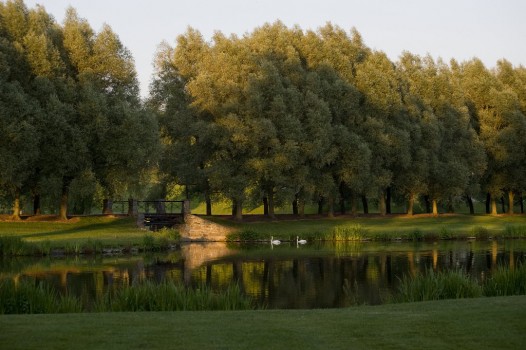By Ben Campbell ‘16
On August 4th, 2014, The Princeton Review rated Colgate University as the most beautiful campus in America, but that’s probably not a huge surprise to anyone who spends time here. As an intern in the Office of Sustainability and as part of our campus-wide pursuit to achieve carbon neutrality by 2019, I decided to take a closer look at the practices that make our campus so beautiful.
First, I looked into the methods employed to keeping the grounds on campus pristine. Facilities maintains over 500 acres of built environment and over 1,000 acres forested land. This requires 18 full time employees and several part time employees using fossil fuel-powered vehicles, such as lawn mowers and trucks, to cut grass, remove refuse, and maintain the general appearance of the campus. These vehicles used to maintain the ground use both gasoline and diesel, non-renewable sources of energy that emit greenhouse gases. According to Colgate’s 2013 Greenhouse Gas Inventory, Facilities emitted approximately 141 metric tons equivalent of CO2 (MTeCO2[1]) from diesel fuel and approximately 46 MTeCO2 from gasoline fuel for activities related to grounds maintenance (i.e. mowing the Seven Oaks Golf Course and grounds of the main campus). Recently, Facilities has implemented a “reduced mowing” regime for over 30 acres of land on the old golf course, Seven Oaks, and the old ski hill. This reduction in mowing (from weekly mowing to now only a couple of times a season) has resulted in an annual savings approximately $2,000 in fuel and labor, and has reduced our carbon emissions by approximately 10 tons, which is the equivalent of not burning 1,125 gallons of gasoline.
During the winters, Facilities is tasked with keeping the many roads and paths on campus snow- and ice-free. Typical ice and snow management involves plowing and laying sodium chloride, a chemical that lowers the freezing point of ice. When sodium chloride (or table salt) runs off streets and walkways into the local ecosystem, it is hazardous to vegetation, water, and many lifeforms. In order to avoid these environmental impacts, Colgate’s snow and ice management team uses magnesium chloride. According to the U.S. EPA, magnesium chloride is a more environmentally friendly de-icing alternative.
As well as emissions from mowing, Colgate has emissions associated with fertilizer usage. However, Colgate only uses organic fertilizers instead of synthetically produced, inorganic fertilizers. In addition, the university uses foliar fertilizer, which is used for spot treatment (as opposed to blanket spraying). Foliar fertilizers reduce the treatment area as well as overall water consumption. Colgate’s ground crew also leaves grass clippings on the ground so they can decompose and return their nutrients back into the soil. Fertilizer application has gone down from 56,828 lbs. in 2009 to 17,630 lbs. in 2013. Although Colgate’s grounds maintenance employs sustainable grounds keeping methods, they still have an impact upon Colgate’s net emissions via the nitrous oxide released.
So how can Colgate further reduce the approximately 170 MTeCO2 of emissions that go towards making our campus more sustainable without compromising the beautiful results? The Sustainable Sites Initiative, which has attempted to create guidelines for sustainable landscapes, has some of the answers to ensuring institutions such as Colgate can be more sustainable:
- Plant selection. By choosing plants that require little pesticides, fertilizer or water can go a long way towards creating a sustainable landscape by reducing the amount of attention the grounds need.
- Controlling water run off. Most students know that when it rains at Colgate the hill turns into a series of flowing rivers, sometimes even taking over entire pathways. By improving drainage or implementing rainwater, capture can reduce erosion, as well as the potential of soil contamination from pesticide and fertilizer run off.
- Increase sustainable uses of Colgate’s land. Colgate’s forested lands were recently certified under the American Tree Farm System for long-term sustainable management. Colgate’s forested lands sequester over 1,500 tons of carbon each year as the trees grow and forests mature. By increasing the campus arboretum, as suggested in the Campus Master Plan, we can further reduce emissions from mowed lawn while increasing the amount of sequestered carbon from new trees.
- Switch fuel sources to renewable or low-carbon alternatives. By switching our mowers from diesel or gasoline to electric, hybrids, or biodiesel, we could mitigate what is a huge emission source for Colgate (approximately 141 MTeCO2) and reduce noise pollution dramatically.
- Educate yourself. From multi-million dollar fundraisers to several day sit-ins, the Colgate community has proven that it is capable of spectacular things. So educate yourself on sustainable practices and support keeping our campus beautiful, as well as sustainable!
Sources:
http://www.sustainablesites.org/
http://www.facilitiesnet.com/groundsmanagement/article/Planting-the-Green-Seed–8935#
http://www.colgate.edu/offices-and-services/facilities-(b-g)/departments
http://www.colgate.edu/docs/default-source/d_distinctly-colgate_sustainability_climate-action-planning/2013-greenhouse-gas-report.pdf?sfvrsn=0
[1] Metric Tons equivalent of CO2 (MTeCO2) is used to denote other greenhouse gases, such as nitrous oxide or methane, as their environmental impact in terms of CO2 so environmental impact is easily comparable.


